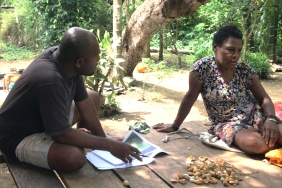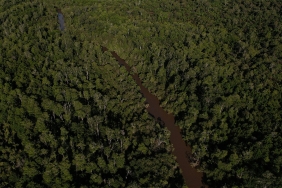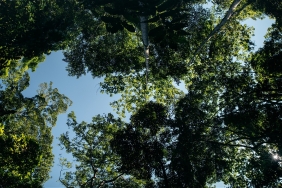SITE STORY: ASMAT
By: Andhiani M. Kumalasari - WWF Indonesia-Papua Program - 2014
If we ask a random person to name one of the tribes in Papua, the majority answer is Asmat. As it is, Asmat is very famous throughout Indonesia and even the world, because of its rich culture, especially carving and sculpture. Far related to art, it turns out that Asmat has something else extraordinary that is not known to many people. Asmat has a variety of great traditional environmental conservation efforts. One of them is a local wisdom inherited from ancestors that requires people in Asmat to maintain the existence of sacred forests (sacred) villages. Indeed, the Asmat indigenous people are gatherers, the life of the community is largely determined by the control of timber and non-timber forest products as a fulfillment of the basic needs of food, culture, health, and transportation in a traditional manner.
Sacred Forest as a Customary Symbol
All villages in Asmat have sacred forests and some even have more than one sacred forest. Why is it sacred? Sacred because from then until now the existence of the forest, both its place and area, has never changed. Let alone cutting down trees or clearing forest land, in the forest there should be no human activity in any form. This is a rule that has been passed down from generation to generation by the ancestors of the Asmat indigenous people. For anyone who violates them, they will get disaster and even death if they do not pay derma (sanctions) according to the rules set by traditional elders for generations.
Sacred forests have different names between one village and another. "The sacred forest here is called Ceserasan, this place has never changed its location, all of us people cannot carry out activities in any form in that place, if we violate we people can be hit by disaster or run out of life (die)," explained Laurensius Bumbere, Head of Atsj Village- Atsj District, Asmat Regency.
Asmat people believe that the spirits of their ancestors will continue to reside and supervise community activities. Violators of the rules are required to pay charity in various forms, including cigarettes, salt, batteries, plates, bark, and firewood.
This understanding and knowledge must continue to be conveyed to the younger generation and successors from generation to generation, the elders and parents must convey and provide an understanding of the existence of sacred forests in the village. Laurensius added, "We people dare not violate or change, because there is already a lot of evidence. The ancestors always monitor the existence of the place and give punishment to those (indigenous people) who violate it. So it must remain and continue to be understood by everyone including the next generation."
Mapping of Indigenous People's Important Places in the Village as Local Wisdom for Environmental Sustainability
As the pace of development activities that are often uncontrolled makes not a few parties worry about the sustainability of sacred forests and other important places in Asmat indigenous villages which are rich in nature and culture. There must be an effort to anticipate the bad things that are feared. The government itself has issued the Regional Spatial Plan (RTRW) of Asmat Regency Number 6 of 2012 2032, Chapter IV on the Regional Spatial Pattern Plan, in the second part of article 18 concerning protected areas, Paragraph C concerning the protection area of the swamp area, coastal area, urban green open space area and spiritual protected areas and other local wisdom. For Papua Province itself, there is Perdasus number 23 of 2008 concerning customary rights of indigenous peoples and individual rights of indigenous peoples to land. While at the national level there is also Law no.26 of 2007 concerning spatial planning, chapter viii article 60-article 66 concerning the rights, obligations and roles of the community.
The various government regulations were then followed up by WWF Indonesia-Papua Program supported by USAID- IFACS and in collaboration with the Asmat District Government, the Asmat Indigenous Peoples Organization (LMAA) and SKP (Secretariat of Justice and Peace) Agats by facilitating the mapping of important places of Asmat indigenous peoples for the village scale. There are two most important things that must be mapped, namely; spiritual places and local wisdom and must be part of the RTRW map and regional utilization map in Asmat Regency.
The mapping process also extracted information on the rules and utilization of natural resources according to traditional values in 39 villages as an effort to strengthen indigenous peoples for the Suru-Suru District, Sawaerma District, Pulau Tiga District, Atsj District, Fayit District, Kolfbraza District and Suator District (administrative data before the division of Districts and Villages). All of these kammpung are covered by 8 Forum Adat Rumpun (FAR) areas that inhabit mapping priority areas, namely Unir Sirau, Safan, Jopmak, Braza, Becembub, Emariducur, Joerat and Aramatak The selection of mapping priority areas with consideration of several aspects:
(1) has a threat to land conversion because it is in the status of limited production forest, conversion production forest and production forest;
(2) is a local refuge;
(3) local villages whose livelihoods depend on the utilization of natural resources; (4) is a corridor of the Natural Resources Park.
(4) is a corridor of Lorentz National Park and is located in a protected forest area.
Furthermore, in this mapping, it was also agreed that there would be rules in the village to:
(1) maintaining the ancestral values of culture and soasil in kampunng;
(2) utilization of natural resources in accordance with local wisdom; and
(3) sustainable and sustainable development.
"The existence of this mapping activity, they feel helped, because this is one of the forces to bind all parties so that the division of territory remains and does not change. Mapping at the village level is a form of support for various regulations and policies that already exist from the government, but we want the understanding not to go through mechanisms that are generally top down," explained Jackson Umbora, Project Leader for WWF Indonesia Program in Asmat district. In this activity, the community is also involved in a participatory manner, they have far more understanding and knowledge than people from outside about the division of territory in their village. They also have the right to participate in determining development activities in the village of their ancestors. They must contribute their knowledge so that later they also have a sense of self belonging to the village map because they have participated in its preparation, they are also asked to name the places that have been mapped with local names.
In addition to being part of the Asmat District RTRW map, this map is also important for providing information to migrants who visit or plan to settle. The existence of this map is also important to provide information about the rights of the community to negotiate if there are development activities in their village, what they must defend their existence.
In addition, this map is also an informative educational tool for the younger generation and successors of the Asmat community of various forms of natural and cultural resources of their ancestral heritage that need to be preserved.
Forest is Mother
The local knowledge possessed by the Asmat community from the heritage of the ancestors has penetrated the dimension of time long before many people talked about various forms of forest conservation efforts such as REDD, National Action Plan -Adaptation to Climate Change (RAN-API), forest management and utilization, etc. What they do is not quite simple, they do what they can. What they do is not quite simple, they simply inherit the knowledge and orders of ancestors and customary elders that in a village the existence of sacred forests is inviolable. This has become a philosophy of life and a form of respect for the universe. The spirits of the ancestors will always provide guidance and warnings that the forest is not an ordinary place. The ancestors have understood that the forest is very important in the midst of community activities.
If we can conclude with the current environmental conditions, it can be said, the ancestors and customary elders already have the knowledge that the forest has many benefits; as a place to live for various types of animals and plants, underground water sources, supply clean air and create a microclimate for the people in the village and will even provide far more and extensive benefits now and in the future.
This local wisdom identity needs to be appreciated. Indigenous people in Asmat are not new actors in forest conservation efforts, they have been doing it for a long time, even if they are asked when the rules about the sacred forest appeared, they cannot provide an answer. They agreed to answer that it was inherited from their ancestors and they got the explanation from their tete (grandfather), nene (grandmother) and parents. They will also do the same, providing understanding to their children and grandchildren as the next generation. Once again, they agree that the sacred forest and other important places in the village must remain as they are for future generations and even forever. For the Asmat people, the forest is a mother who provides life through all forms of natural resources. This understanding is indeed tied to the origin of the Asmat tribe's existence. Asmat itself comes from two words, As-man-and Amat-tree, Asmat- tree man.
Let's fantasize a little, if all people in Indonesia at least have the same knowledge and local wisdom as what happened in 39 Asmat villages, of course Indonesia's forests will continue to be shady. Indonesia will always be one of the countries with the highest oxygen exports in the world. A simple lesson we can adapt from the unpretentious Asmat people is that everyone must contribute to forest conservation for the sustainability of present and future life.





